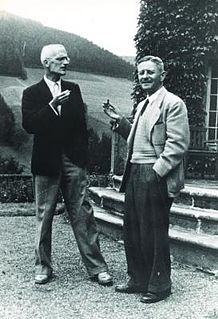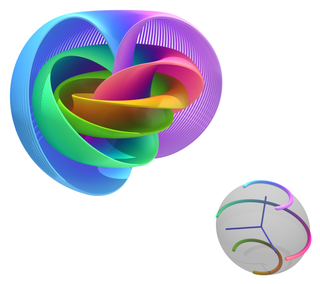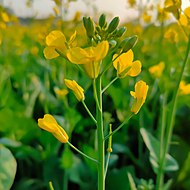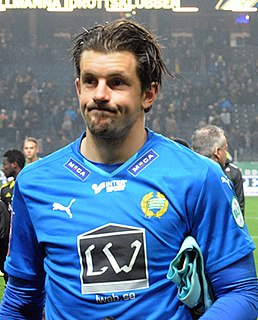Karl Hopf may refer to:
Karl Hopf may refer to:
The concept of supergroup is a generalization of that of group. In other words, every supergroup carries a natural group structure, but there may be more than one way to structure a given group as a supergroup. A supergroup is like a Lie group in that there is a well defined notion of smooth function defined on them. However the functions may have even and odd parts. Moreover, a supergroup has a super Lie algebra which plays a role similar to that of a Lie algebra for Lie groups in that they determine most of the representation theory and which is the starting point for classification.
Skein relations are a mathematical tool used to study knots. A central question in the mathematical theory of knots is whether two knot diagrams represent the same knot. One way to answer the question is using knot polynomials, which are invariants of the knot. If two diagrams have different polynomials, they represent different knots. In general, the converse does not hold.
In mathematics, a Hopf algebra, named after Heinz Hopf, is a structure that is simultaneously a algebra and a coalgebra, with these structures' compatibility making it a bialgebra, and that moreover is equipped with an antiautomorphism satisfying a certain property. The representation theory of a Hopf algebra is particularly nice, since the existence of compatible comultiplication, counit, and antipode allows for the construction of tensor products of representations, trivial representations, and dual representations.

Heinz Hopf was a German mathematician who worked on the fields of topology and geometry.

In the mathematical field of differential topology, the Hopf fibration describes a 3-sphere in terms of circles and an ordinary sphere. Discovered by Heinz Hopf in 1931, it is an influential early example of a fiber bundle. Technically, Hopf found a many-to-one continuous function from the 3-sphere onto the 2-sphere such that each distinct point of the 2-sphere is mapped from a distinct great circle of the 3-sphere. Thus the 3-sphere is composed of fibers, where each fiber is a circle — one for each point of the 2-sphere.
Antipode or Antipodes may refer to:
Supercritical may refer to:

In mathematics, the Poincaré–Hopf theorem is an important theorem that is used in differential topology. It is named after Henri Poincaré and Heinz Hopf.

In mathematical knot theory, the Hopf link is the simplest nontrivial link with more than one component. It consists of two circles linked together exactly once, and is named after Heinz Hopf.

The mustard plant is a plant species in the genera Brassica and Sinapis in the family Brassicaceae. Mustard seed is used as a spice. Grinding and mixing the seeds with water, vinegar, or other liquids creates the yellow condiment known as prepared mustard. The seeds can also be pressed to make mustard oil, and the edible leaves can be eaten as mustard greens.
Shuffling is a procedure used to randomize a deck of playing cards.
Ludwig Hopf was a German-Jewish theoretical physicist who made contributions to mathematics, special relativity, hydrodynamics, and aerodynamics. Early in his career he was the assistant to and a collaborator and co-author with Albert Einstein.

Per Johannes Hopf is a Swedish former professional footballer who played as a goalkeeper. He played professionally in Sweden with Hammarby IF as well as in Turkey with Gençlerbirliği S.K. and Ankaragücü.
Karl Hopf or Carl Hermann Friedrich Johann Hopf was a historian and an expert in Medieval Greece, both Byzantine and Frankish.

Jon Morrow Lindbergh is a former underwater diver from the United States. He has worked as a United States Navy demolition expert and as a commercial diver, and was one of the world's earliest aquanauts in the 1960s. He was also a pioneer in cave diving. He is the oldest surviving child of aviator Charles Lindbergh and writer Anne Morrow Lindbergh.

The Barony of Veligosti or Veligosti–Damala was a medieval Frankish fiefdom of the Principality of Achaea, originally centred on Veligosti in southern Arcadia, but also came to include the area of Damala in the Argolid when it came under a cadet branch of the de la Roche family in the 1250s. After Veligosti was lost to the Byzantines towards 1300, the name was retained even though the barony was reduced to Damala.
Margaret, Lady of Lisarea was lady of the fief of Lisarea in the Principality of Achaea, around 1276.
Karl Wilhelm Andreas Strehl was a German physicist, author and mathematician. He is notable for the Strehl ratio, a widely used measurement for the optical quality of an imaging system.
Annie Stebler-Hopf also known as Anny or Anna Hopf, was a Swiss born painter.
Karl Hopf was a German serial killer. He was sentenced to death on January 19, 1914 for murdering his wives, father and daughter, as well as attempting to murder other people from the Frankfurt jury.